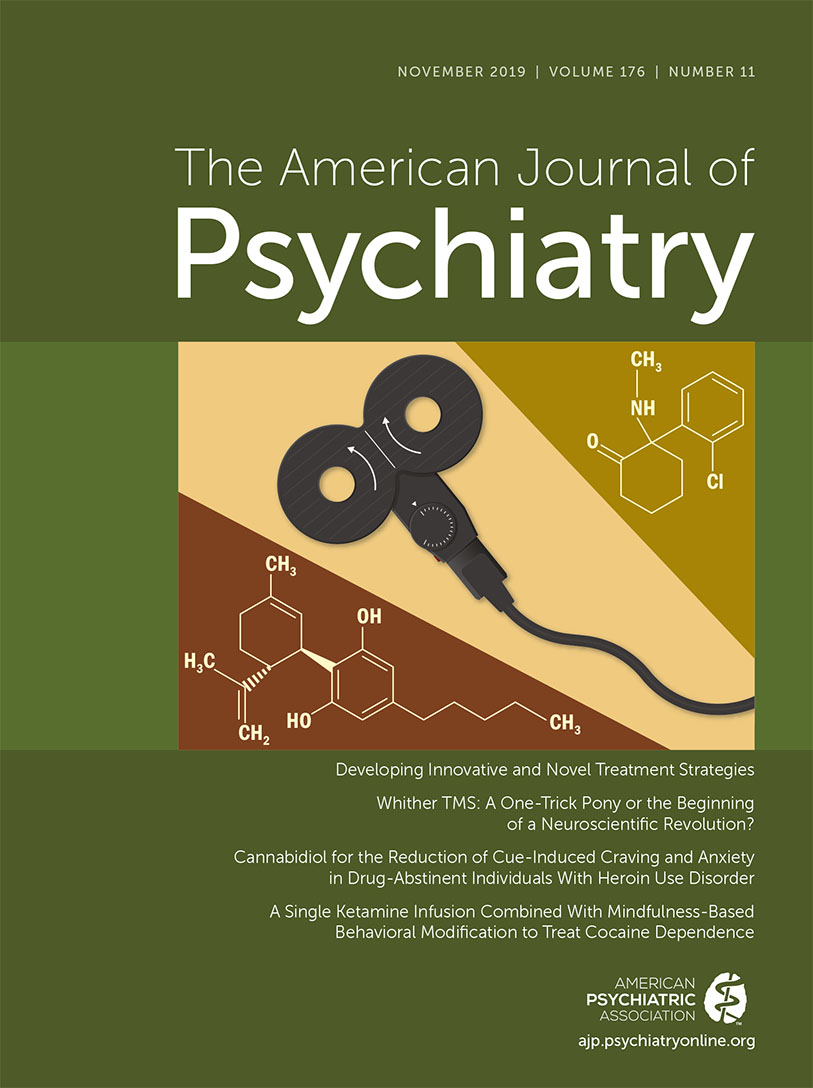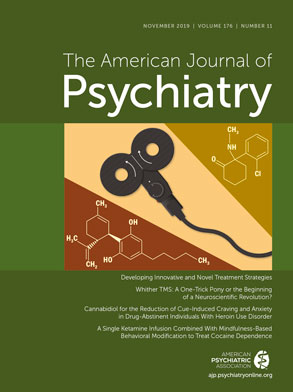Suicide is a major public health concern. Rates of suicide have increased in the United States, with most states experiencing a greater than 30% increase in deaths by suicide across the past 20 years (
1). Despite decades of research, our efforts at suicide prevention remain limited. One reason is that most identified risk factors for suicide, such as demographic characteristics, psychiatric conditions, or prior suicidal behaviors, are unchangeable or not readily modifiable. By contrast, insomnia offers promise as a risk factor for suicide and suicidality because it is time varying, proximal, and modifiable. Growing evidence suggests that insomnia is associated with suicide and suicidality (i.e., suicidal ideation and behavior) independent of well-established risk factors for suicide, such as depression and hopelessness (
2). In light of mounting evidence, sleep disturbances, especially insomnia and nightmares, are now listed as one of the top 10 warning signs by the Substance Abuse and Mental Health Services Administration.
What makes insomnia a particularly auspicious target for suicide prevention is that we have effective interventions. Traditional treatments for depression do not target insomnia, which is the most common residual symptom of depression and which significantly increases risk for relapse (
3). On the other hand, insomnia treatments given to patients with major depressive disorder can lead to improvements in insomnia, core symptoms of depression, and even suicidality (
4). The scarcity of therapeutic evidence for suicide prevention is in large part due to the limited number of randomized controlled trials of psychopharmacological interventions among patients with active suicidal ideation. More specifically, few randomized controlled trials of insomnia interventions in patients with major depressive disorder have actively selected participants with suicidal ideation. These gaps in research highlight the innovation and impact of the article in this issue by McCall and colleagues, “Reducing Suicidal Ideation Through Insomnia Treatment (REST-IT): A Randomized Clinical Trial” (
5). REST-IT takes the important next step of determining whether insomnia treatment can reduce suicidal ideation among patients with major depression and active suicidal ideation.
In a multisite double-blind parallel-arm randomized clinical trial, REST-IT examined controlled-release zolpidem relative to placebo among 103 outpatient adults with major depressive disorder, insomnia, and active suicidal ideation. All participants were prescribed an open-label selective serotonin reuptake inhibitor through 8 weeks of treatment. They also completed well-validated measures of insomnia symptoms and suicidal ideation, both by self-report (Scale for Suicide Ideation) and through clinician assessment (Columbia–Suicide Severity Rating Scale [C-SSRS]). The study design serves as a benchmark for future studies conducting randomized controlled trials of suicidality with outpatients (
6). Few randomized controlled trials for suicidality include participants with active suicidal ideation, relying instead on more distal predictors such as prior suicide attempts. Psychopharmacological trials for new medications also commonly exclude patients at suicide risk, resulting in a lack of evidence-based therapeutic methods for patients with active suicidality. If we are to tackle the challenge of preventing suicide, a transdiagnostic phenomenon, we must conduct randomized controlled trials among participants with a range of disorders and with active suicidal ideation. How else are we to understand the effects of treatments on reducing suicidality and identify new prevention targets?
McCall and colleagues found no worsening of suicidal ideation or emergence of suicidal behavior in their trial. This is important because suicidality is listed as a side effect of zolpidem in the prescribing information approved by the Food and Drug Administration (FDA). The reported risk of suicidality with zolpidem could reflect preexisting severe suicidality, or undiagnosed or untreated depression. More broadly, results from this trial may help to quell concerns among researchers about the safety and feasibility of randomized controlled trials for suicidality and about including participants with active mild suicidal ideation in other types of trials. The word “mild” is key, however, as the research team excluded patients with more severe suicidal ideation (i.e., any suicidal plans or intent). This exclusion highlights an important consideration for future researchers using a similar approach. It also leaves unanswered the question about the effects of zolpidem among individuals with more severe suicidal ideation.
Study results demonstrated a significant advantage for zolpidem compared with placebo on clinician-reported, but not self-reported, suicidal ideation. The difference on these coprimary outcomes may reflect different aspects of suicidality or different gradations of severity, and it highlights the importance of multimodal assessments of suicidality. Both zolpidem- and placebo-treated patients also experienced reductions in insomnia, depression, and suicidality across the study, with no group differences at the primary study endpoint of 8 weeks. Reductions in insomnia symptoms correlated with reductions in suicidal ideation across the 8-week study period, which supports the utility of targeting insomnia in suicide prevention efforts. However, the results also suggest that zolpidem may be efficacious for reducing suicidal ideation only among individuals with severe insomnia, and observed effect sizes were relatively small overall. These findings call into question whether the potential benefits of zolpidem outweigh its risks, which include sedation and complex sleep-related behaviors. These rare but potentially life-threatening incidents resulted in the FDA issuing a black box warning in 2019. Finally, the effect of zolpidem on suicidal ideation was observed over a relatively short follow-up period; longer-term effects and optimal treatment duration remain open questions.
So, where do we go from here? First, we need to better understand the neurobiological mechanisms linking insomnia and suicidality. Sleep loss impairs top-down regulatory systems, observed both by reduced functional activity in the prefrontal cortex (PFC) and by impairments in executive functioning (
7). These same cognitive deficits also differentiate individuals with suicide attempts compared with those with suicidal ideation only (
8). However, most of what we know about neural mechanisms linking sleep to suicidality stems from research on sleep deprivation or restriction. Insomnia is not the same as sleep deprivation. Therefore, more research is needed to examine the neural mechanisms linking insomnia per se with suicidality. Another potential avenue of research is identifying which aspects of sleep drive suicidality. Applying the sleep health framework (
9) may help to understand whether specific sleep characteristics (quality, alertness, duration, timing, efficiency, and regularity) or their cumulative effects are most important. For instance, late sleep timing combined with frequent awakenings may be particularly relevant in suicide prevention: suicide rates are higher at nighttime, potentially implicating both sleep loss and circadian factors (
10). Focusing on multiple dimensions of sleep can inform and prioritize specific sleep targets to help reduce suicidality.
The question also remains as to whether other insomnia interventions would be equally—if not more—effective in reducing suicidality. Thus, trials could be conducted with other classes of hypnotic drugs, such as sedating heterocyclic agents (e.g., trazodone and doxepin) and orexin receptor antagonists (e.g., suvorexant), to determine their efficacy (
11). Cognitive-behavioral therapy for insomnia (CBT-I) is the first-line treatment for insomnia (
12) and has demonstrated effectiveness in reducing depression and potentially suicidality (
4,
13). CBT-I may be particularly effective given that dysfunctional attitudes about sleep mediate the relationship between insomnia symptoms and suicidal ideation (
14). It is also possible that CBT-I as an adjunct to depression treatment reduces both depression (
15) and suicidality. Lower-cost, efficacious, and scalable CBT-I options may also be worth examining, including brief behavioral treatment for insomnia (
16) and self-guided online CBT-I programs (
17). For instance, the Sleep Healthy Using The Internet (SHUTi) program reduces depression symptoms and may similarly reduce suicidality.
The study by McCall and colleagues does not provide all of the answers for using sleep treatments to reduce suicidality, but it provides an important methodological step and opens the door for future randomized controlled trials. Building on these findings may extend into other psychiatric disorders known to be affected by sleep disturbances and suicidality, such as posttraumatic stress disorder and schizophrenia. With the first steps taken by this study targeting insomnia to reduce suicidal ideation in patients with active suicidality, we may yet start to bend the curve in reducing suicidality and preventing suicide.

